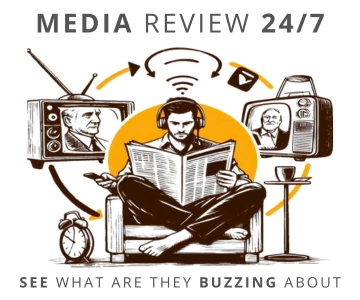Why do internet users listen to podcasts:
- 47% - to learn something new
- 36% - for entertainment
- 36% - to stay up to date with local and global events
- 33% - for educational or developmental purposes
- 24% - to pass the time
- 22% - to make better use of time during simple tasks
- 14% - to have interesting topics for social conversations
source: Ariadna National Research Panel for Wprost, April 29 - May 3, 2022
Podcasts are most commonly listened to at home, with over three-quarters of Ariadna panel respondents giving this answer. The second most popular location is in the car, though it is mentioned ten times less often.
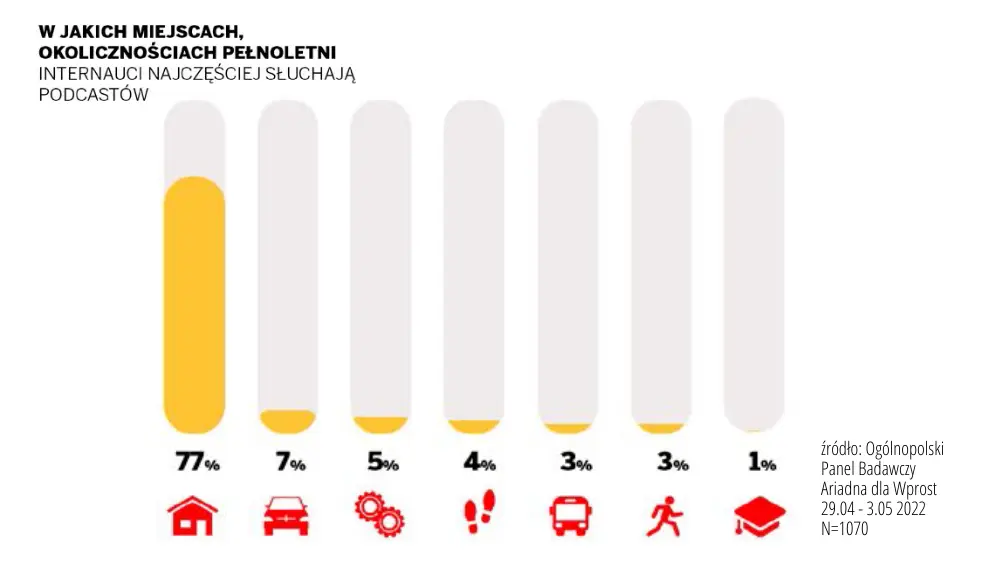
According to the Wprost study, podcast listeners typically have one or two favorite shows. This was the response of 63% of respondents. Financially, 12% of active listeners support their favorite creators. Half of these supporters make monthly contributions, and the same number purchase books by their favorite podcast authors.
Most preferred podcast topics:
- 35% - health and lifestyle
- 34% - news
- 31% - interviews with notable figures
- 20% - comedy
- 19% - crime
- 18% - sports
- 18% - culture
- 14% - personal finance
- 12% - business
- 6% - running a company
- 7% - other topics
source: Ariadna National Research Panel for Wprost
Six out of ten active users listen to podcasts most often in the evenings (between 6 PM and 11 PM), primarily at home (75%). They may also engage with content posted by creators on social media (47%), most likely on Facebook (61%) - as noted by the authors of the Wprost and Studio PLAC podcast report.

YouTube is the clear leader among podcast platforms, used by three-quarters of listeners. Websites of creators and Spotify follow, albeit with significantly lower popularity.

The Wprost podcast market study also examined factors influencing a show`s popularity. What do listeners value most when choosing a podcast? The recipe for success seems to lie in content quality, relevance, and guest appearances.
What factors matter most to listeners when choosing a podcast:
- 49% - content quality
- 40% - relevance to current events
- 37% - participants
- 30% - hosts` voice and diction
- 18% - technical quality
- 12% - the host is a notable figure
- 10% - popularity or ranking position
- 2% - other
source: Ariadna National Research Panel for Wprost
The Wprost and Studio PLAC study was conducted from April 29 to May 3, 2022, on a sample of 1,070 internet users.
The Polish Podcast Listener 2021: Tandem Media Report
A detailed report on the Polish podcast market in 2021 was released by Tandem Media from Agora Radio Group in July and August of that year. This is the third edition of the most comprehensive study of Polish podcast listeners.
- Podcasts are growing rapidly worldwide. Though it’s the youngest medium, its popularity has soared in recent years, as evidenced by the increasing number of podcast series, episodes, and creators, comments Maciej Moszczyński, managing director of Tandem Media. - Currently, on-demand internet broadcasts have the highest reach in Ireland, Spain, Sweden, Norway, and the US, but I am confident Poland is quickly heading in the same direction.
According to data from the Tandem Media "Polish Podcast Listener" study conducted by Publicis Groupe, monthly podcast reach among Polish internet users in 2021 increased to 31.3%. This means nearly one in three Polish internet users - or almost 9 million people - listen to podcasts!
Podcast consumption frequency is also rising. Weekly reach increased by over 4 percentage points compared to 2020, reaching 21.3%. This trend is supported by the growing number of on-demand podcast series available in Poland, with over 7,000 titles added to open distribution since 2019.
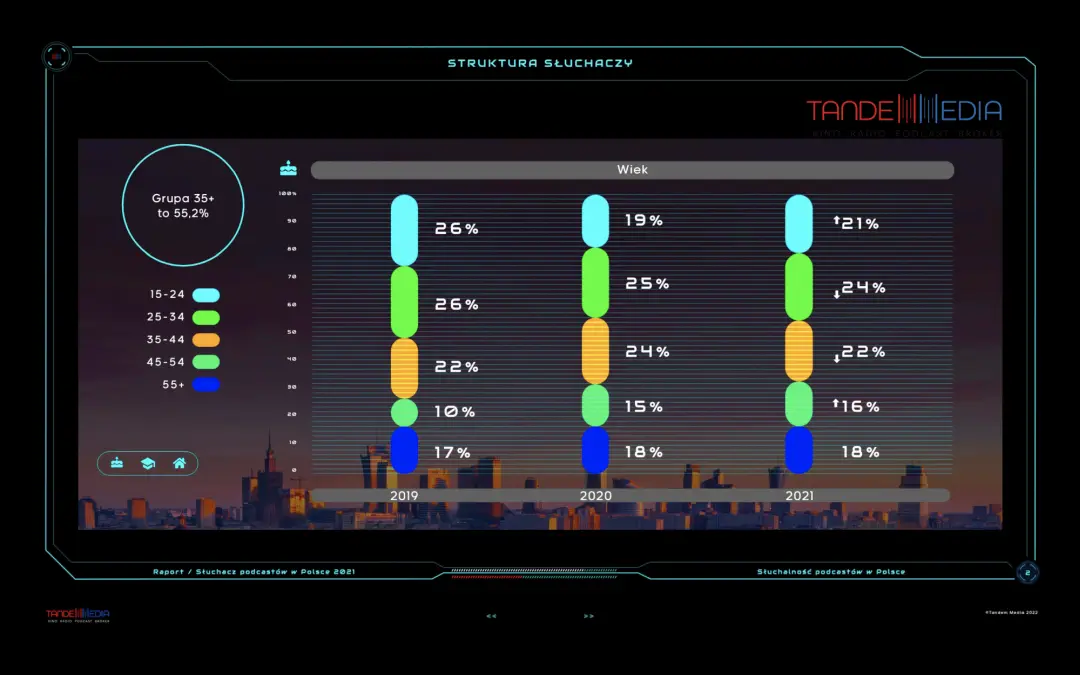 source: Polish Podcast Listener 2021. Tandem Media Report
source: Polish Podcast Listener 2021. Tandem Media ReportThe latest Tandem Media study also provides valuable insights into podcast listeners in Poland. It confirms that podcasts reach a specific and attractive audience. The largest group of listeners is aged 35+. Nine out of ten podcast listeners have at least a secondary education, and nearly half have higher education. Moreover, podcasts are growing in popularity across the country. While most listeners are urban residents, the medium also reaches smaller towns and rural areas.
 source: Polish Podcast Listener 2021. Tandem Media Report
source: Polish Podcast Listener 2021. Tandem Media ReportPodcast listeners appreciate the medium`s benefits, such as its convenience during other activities and its ability to provide knowledge, expert opinions, and hobby-related content. Podcasts are also valued for offering relief to eyes fatigued by other media.
As in previous years, the Tandem Media report confirms that podcast content is trusted by audiences. It is considered valuable and expert-driven. Moreover, 25% of podcast listeners say they spend less time watching traditional TV, and 21% spend less time on the internet.
- The high ratings podcasts receive as a trustworthy and engaging medium, and the shift in audience attention from other media to podcasts, are increasingly drawing advertisers` interest, adds Michał Dobrzański, head of analysis and business support at Tandem Media. - Global spending on digital audio advertising, including podcasts, is rapidly growing. Moreover, branded content in podcasts enjoys high acceptance among users.
Why and How Do We Listen to Podcasts? Tandem Media Analysis
- By 2020, we observed increased podcast consumption among Poles, partly influenced by the pandemic. In 2021, we saw one-third of internet users in Poland listening to podcasts more frequently than in the previous year. Weekly reach rose, with one in five internet users listening at least once a week, explains Radosław Sączek, creative group head at Tandem Media. - The number of podcast series being listened to has also increased. In 2021, most respondents listened to two to four series, compared to two years ago when the largest group engaged with only one.
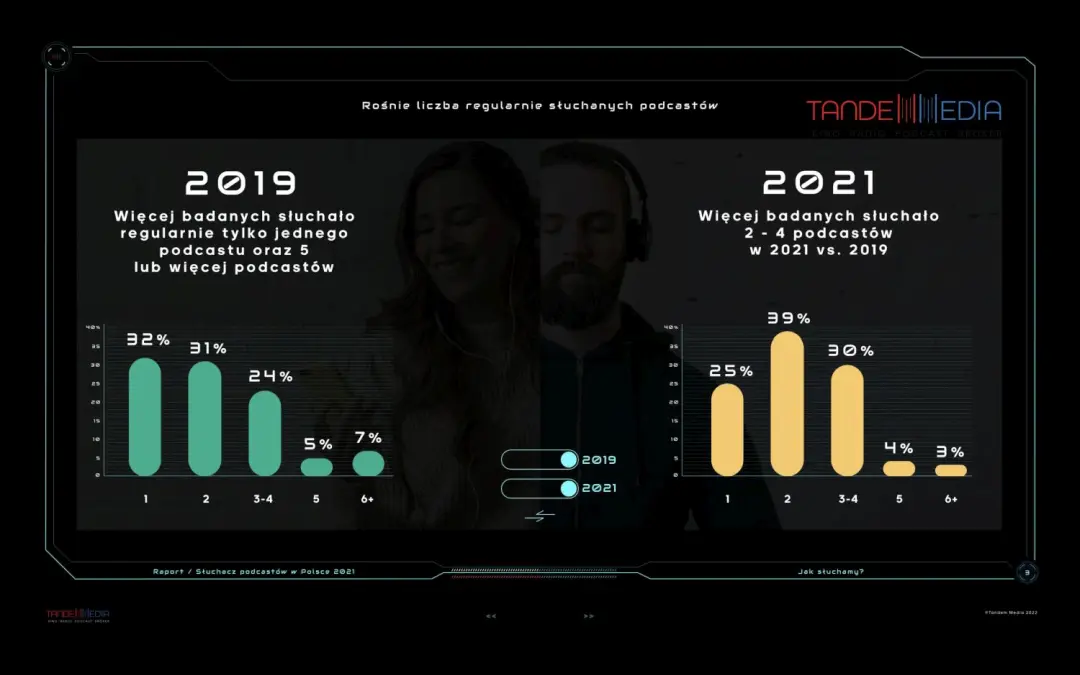 source: Polish Podcast Listener 2021. Tandem Media Report
source: Polish Podcast Listener 2021. Tandem Media ReportListeners prefer consuming podcasts at home - this was declared by 83% of respondents. Podcasts are also enjoyed in cars, on walks, during commutes, at work, and while exercising. Late afternoons, evenings, and nights are the most popular times for podcast listening, chosen by 68% of listeners. Smartphones are the preferred device for listening (53%), followed by laptops (23%).
Exactly half of podcast listeners tune in for entertainment - to relax and unwind. Many also use podcasts to learn about the world or to have something to do during other activities. Some listeners gain expert knowledge or insights into their hobbies. Popular podcast categories include health and lifestyle, entertainment, crime, music, news and politics, psychology, and history and society.
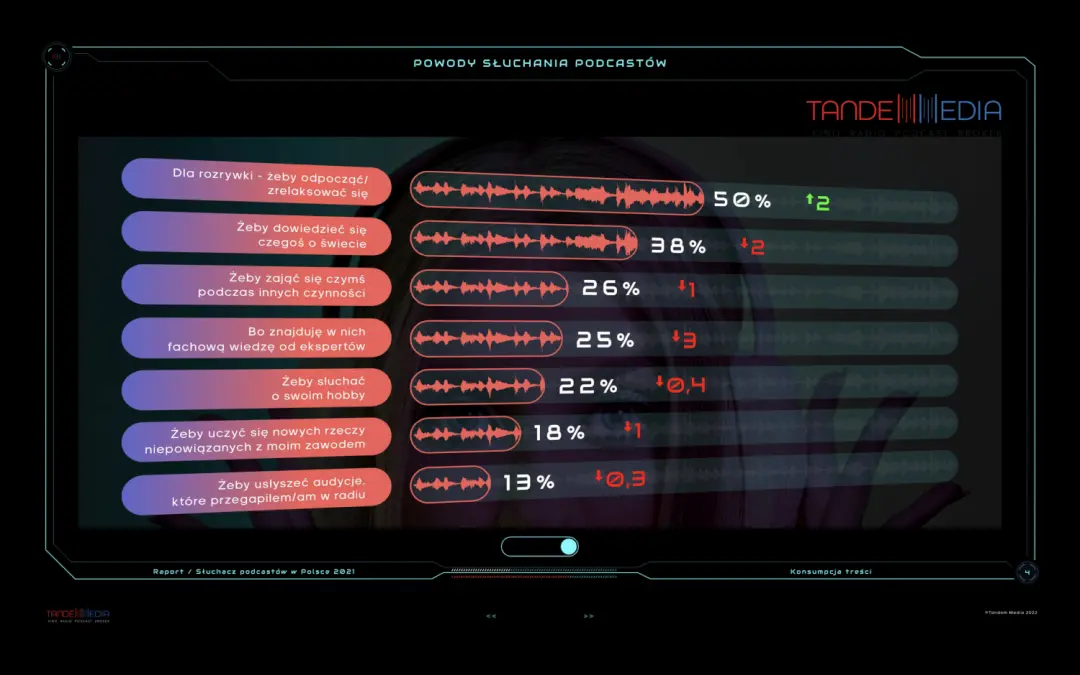 source: Polish Podcast Listener 2021. Tandem Media Report
source: Polish Podcast Listener 2021. Tandem Media ReportNotably, 76% of podcast listeners share content through conversations, recommendations, or at work. They learn about new shows online, from social media, friends, family, or favorite creators.
Podcast Listeners Embrace Advertising
- Our study shows that half of Polish listeners have encountered ads during podcasts, and nearly half have listened to brand-sponsored episodes. This indicates that advertisers are increasingly incorporating podcasts into their media plans, explains Radosław Sączek, creative group head at Tandem Media. - Globally, the number of branded podcasts has surged, doubling in Apple’s catalog in 2021. While there is room for growth in Poland, interest from marketers in this communication form has been rising over the past year.
Promotional content related to podcasts is well-received - over two-thirds of listeners accept brand-sponsored episodes or collaborations between podcasters and brands. Almost as many are open to episodes created by brands, and nearly half tolerate ads during podcasts.
Moreover, podcast audiences pay attention to promotional content and act on it. As many as 65% visit websites mentioned in podcast episodes, over 40% follow podcasters on social media, and one-quarter are willing to purchase advertised products.
- All this proves that podcast listeners embrace advertising, and promotional content tied to this medium can be highly effective, concludes Michał Dobrzański, head of analysis and business support at Tandem Media. - It’s no surprise that global spending on podcast advertising is projected to grow from $2.3 billion in 2021 to $4.2 billion by 2026.
Research conducted by Tandem Media, executed by Publicis Groupe, November 2021. Respondents included internet users aged 15+ ("Polish Podcast Listener" report, N=7197; CAWI, Tandem Media/Publicis Groupe).
COMMERCIAL BREAK
New articles in section Media industry
Advertising market 2025. Poland, Europe and the World
Marcin Grządka
The global advertising market is growing by 8.8% in 2025 and will reach a value of 1.14 trillion dollars. The industry result in Europe records slightly lower dynamics, at the level of 5.8%. In this comparison, Poland performs clearly above the average. We will record an increase of 8.9% this year and a value of 18.56 billion PLN - estimates WPP Media in the annual report "This Year Next Year".
The print media market 2025. Three global trends
Krzysztof Fiedorek
The market value is 359.53 billion dollars, yet the erosion is visible to the naked eye. The decline for newspapers will amount to -2.3 percent. Despite this, print retains strength: it generates 76 percent of subscription revenues and enjoys 82 percent consumer trust. The future of the industry is defined by hybrid strategies and niche specialization.
Journalism in the age of AI. Why people prefer humans over machines
Krzysztof Fiedorek
Only 12% of people accept news created solely by AI, while 62% prefer those written by humans. At the same time, only 19% notice labels indicating the use of artificial intelligence, while younger audiences ask AI to explain the content to them. These are the findings of the Reuters Institute report on artificial intelligence in media.
See articles on a similar topic:
New Technologies in Journalism. PressInstitute Study
BARD
Nearly 39% of journalists use their smartphone or tablet camera to record videos, while over 26% use the built-in camera to take photos that they later publish, according to the "Journalists and New Technologies" study by PressInstitute.
Digital media addiction. Why the brain can’t cope
KFi
Digital media can hijack the brain's reward system in ways similar to drugs and alcohol, warned psychiatrist and author Anna Lembke. She emphasized that compulsive use of digital platforms can become a serious addiction. Not just a bad habit or risky behavior.
Trends in Media and Entertainment. DataArt Predictions for 2019
KF
Increasing consumption of content on mobile devices, growing demand for on-demand services, and the rapid development of user-generated content are the trends expected to dominate the tech sector in 2019, according to DataArt, a global technology consulting firm.
Fake News and Disinformation in Poland. Scale, Impact and Future
Bartłomiej Dwornik
Where do the sources of disinformation lie, and how large is the scale of this wave? Why are we so susceptible to false information, and what role do traditional media play in this puzzle? Let’s shed some light on these issues and face the question: can the battle against the flood of disinformation still be won?







